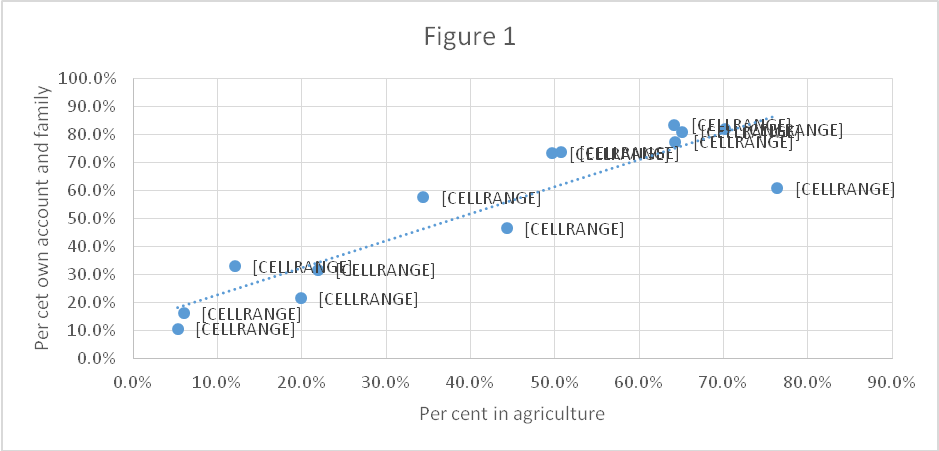The Southern African Development Community III – Education And Labour Market
Introduction: the Human Development Index
The United Nations Human Development Index is the geometric mean of the three indices. The health dimension is assessed by life expectancy at birth, the education dimension is measured by mean of years of schooling for adults aged 25 years and more and expected years of schooling for children of school entering age. The standard of living dimension is measured by gross national income per capita. The median value for the top 30 countries was world was 0.74 in 2019, while the median value for SADC countries is 0.58.
Table 1 sets out the HDI for the sixteen SADC countries.
Table 1
|
Human Development Index |
Countries |
|
0.700 and higher |
Mauritius, Seychelles, Botswana, South Africa |
|
Between 0.600 and 0.699 |
Namibia, Eswatini |
|
Between 0.500 and 0.599 |
Zambia, Angola, Zimbabwe, Comoros, Tanzania, Madagascar, Lesotho |
|
Less than 0.500 |
Malawi, DRC, Mozambique |
Only Mauritius and Seychelles have HDI values above the world median.
Education
The net enrolment rate is the number of enrolments at appropriate ages as a percentage of all children of the same ages in each phase of school education. Net enrolment rates at the last reported year between 2014 and 2019 are presented here. There are gaps in the data. The median net enrolment rate at the primary level for 13 countries was 97.6%, at the lower secondary level was 11 countries was 82.6% and at the higher secondary level was 58.1%. Mozambique and Tanzania were the only countries reported to have lower than a 50% net enrolment rate at lower secondary and higher secondary levels, joined by Madagascar and Malawi at the higher secondary level. The consequence is that the median literacy among the 15-24 year age group is 86% among 15 reporting countries. Table 2 sets out literacy rates by country.
Table 2
|
Literacy rates 15-24 |
Countries |
|
90% and above |
Namibia, Mauritius, Botswana, Eswatini, South Africa, Zambia |
|
80 – 89% |
Lesotho. Tanzania, DRC |
|
Less than 80% |
Comoros, Angola, Madagascar, Malawi, Mozambique |
|
Missing |
Seychelles, Zimbabwe |
The median expenditure on education as a percentage of total government expenditure across 15 countries was 18.3%, with Eswatini, Tanzania and Botswana above 20%. Aggregate enrolment in vocational secondary education among 13 reporting countries was 1.7 million, and aggregate enrolment in tertiary education among 13 countries reporting was 2.6 million, with South Africa accounting for 46% of them.
The labour market
The population of working age (between 15 and 64) in SADC countries (excluding Seychelles) was 195 million in 2019. Of these, 76.2% were economically active, creating a labour force of 149 million. Labour force participation rates vary considerably across countries, as Table 3 shows.
Table 3
|
LFPR |
Countries |
|
80% and above |
Zimbabwe, Madagascar, Tanzania, Angola, Mozambique, Botswana, Malawi |
|
70.0 - 79.9% |
Lesotho, Zambia |
|
60.0 - 69.9% |
Mauritius, DRC, Namibia, South Africa |
|
Below 60% |
Eswatini, Comoros |
In turn, 90.6% or 135 million were working. Open unemployment rates by country are presented in Table 4.
Table 4
|
Unemployment rate |
Countries |
|
Less than 10% |
Madagascar, Tanzania, DRC, Mozambique, Malawi, Mauritius, Comoros, Angola |
|
10-20% |
Zambia, Zimbabwe, Namibia |
|
Above 20% |
Lesotho, Botswana, Eswatini. South Africa |
Of the employed people, 3.0% are employers, 29.3% are employees, 50.3% own account workers and 17.4% contributing family members. 55.5% are employed in agriculture, 10.0% in industry (mining, manufacturing, utilities and construction) and 34.5% in services. The percentage of own account and family workers is closely associated with the percentage employed in agriculture as Figure 1 shows. Most farming is subsistence/peasant farming. There are some own account and family workers in services as well.

Earnings
Incomplete data exist on:
- Average agricultural output per worker per month (in countries where more than 40% of workers are employed in agriculture).
- The average monthly wage among employed agricultural workers
- The average monthly wage among employed workers in elementary occupations
- The average monthly wage among employed workers in private households.
Table 5 sets out the information in US dollars at current exchange rates for the latest observations from 2015 onwards. The three small island economies of Comoros, Mauritius and Seychelles are excluded.
The data show the following:
- The opportunity cost of removing a worker from subsistence agriculture was about US $ 30 per month in the south, and roughly double that in the northern countries of Angola, DRC and Tanzania.
- The remaining columns can be taken as indications of the unskilled wage, though agricultural wages considered as such will be upwardly biased by the inclusion of skilled agricultural workers, especially in Eswatini, Namibia and Zambia.
Table 5
|
Country |
Agricultural output per worker |
Average monthly wage - agriculture |
Average monthly wage –elementary occupations |
Average monthly wage – private households |
Unemployment Rate (%) |
|
Angola |
81 |
9.6 |
|||
|
Botswana |
103 |
22.6 |
|||
|
DRC |
46 |
3.4 |
|||
|
Eswatini |
201 |
144 |
72 |
22.7 |
|
|
Lesotho |
27 |
94 |
119 |
112 |
22.4 |
|
Madagascar |
32 |
39 |
32 |
20 |
1.8 |
|
Malawi |
26 |
5.8 |
|||
|
Mozambique |
37 |
3.4 |
|||
|
Namibia |
244 |
94 |
19.9 |
||
|
South Africa |
193 |
29.2 |
|||
|
Tanzania |
77 |
62 |
2.1 |
||
|
Zambia |
17 |
120 |
99 |
57 |
12.0 |
|
Zimbabwe |
30 |
16.9 |
Sources
- IMF World Economic Outlook Database, April 2021
- World Bank Development Indicators
- ILO, ILOSTAT Database
Conclusion
Apart from the three small island economies, the SADC labour market accords with the Lewis model[1], in terms of which labour is increasingly withdrawn from peasant agriculture and re-employed in unskilled work elsewhere as development proceeds. There is one important qualification: the Lewis model did not allow for unemployment, which is high in all SADC countries with a relatively small agricultural sector. It will take a long time for the transfer to complete and, in the intervening period, there will be little upward pressure on the unskilled wage. Meanwhile, secondary education, in particular, has reached fairly advanced levels and net enrolments can be expected to continue to rise. Unless SADC economies can grow very fast, disappointed expectations on the part of the young are bound to increase.
Charles Simkins
Head of Research
charles@hsf.org.za
Annexure – Supporting tables
Table 1
|
Human Development Index |
Net enrolment rate |
Youth literacy rate |
Government expenditure education |
|||
|
Primary |
Lower secondary |
Upper secondary |
||||
|
2019 |
% |
% |
% |
15-24 |
% of total |
|
|
Angola |
0.581 |
77.4 |
8.7 |
|||
|
Botswana |
0.735 |
88.9 |
97.5 |
20.5 |
||
|
Comoros |
0.554 |
81.9 |
80.8 |
50.1 |
78.3 |
13.3 |
|
Democratic Republic of Congo |
0.480 |
85.0 |
14.0 |
|||
|
Eswatini |
0.611 |
83.7 |
97.2 |
83.8 |
95.5 |
24.8 |
|
Lesotho |
0.527 |
97.6 |
82.6 |
66.1 |
86.6 |
13.9 |
|
Madagascar |
0.528 |
97.7 |
70.0 |
36.2 |
74.1 |
19.8 |
|
Malawi |
0.483 |
98.1 |
81.4 |
31.1 |
72.9 |
15.8 |
|
Mauritius |
0.804 |
98.6 |
95.3 |
79.0 |
99.0 |
18.7 |
|
Mozambique |
0.456 |
97.6 |
56.9 |
31.1 |
70.9 |
17.9 |
|
Namibia |
0.646 |
98.4 |
91.5 |
99.1 |
11.7 |
|
|
Seychelles |
0.796 |
97.6 |
99.5 |
81.9 |
||
|
South Africa |
0.709 |
89.0 |
85.6 |
79.3 |
95.3 |
19.5 |
|
United Republic of Tanzania |
0.529 |
86.6 |
28.3 |
14.2 |
85.8 |
20.6 |
|
Zambia |
0.584 |
85.1 |
92.1 |
17.0 |
||
|
Zimbabwe |
0.571 |
|||||
|
Median |
0.576 |
97.6 |
82.6 |
58.1 |
86.2 |
18.3 |
Sources
- United Nations Human Development Index
- UNESCO Institute for Statistics
Table 2
|
Population 15-64 (Thousands) |
Labour force participation rate (%) |
Labour force (Thousands) |
Unemployment rate (%) |
Employment (Thousands) |
Agricultural employment |
Own account and family employment |
|
|
2019 |
2019 |
2019 |
2019 |
2019 |
(%) |
(%) |
|
|
Angola |
16307 |
83.1 |
13543 |
9.6 |
12243 |
50.7% |
73.7% |
|
Botswana |
1426 |
80.7 |
1151 |
22.6 |
891 |
19.9% |
21.5% |
|
Comoros |
492 |
48.0 |
236 |
8.1 |
217 |
34.4% |
57.6% |
|
Democratic Republic of Congo |
44284 |
66.8 |
29577 |
3.4 |
28571 |
64.3% |
77.3% |
|
Eswatini |
669 |
56.3 |
376 |
22.7 |
291 |
12.0% |
33.0% |
|
Lesotho |
1209 |
79.1 |
956 |
22.4 |
742 |
44.3% |
46.5% |
|
Madagascar |
15251 |
90.7 |
13837 |
1.8 |
13588 |
64.1% |
83.4% |
|
Malawi |
10046 |
80.2 |
8061 |
5.8 |
7593 |
76.3% |
60.9% |
|
Mauritius |
897 |
67.7 |
607 |
6.3 |
569 |
6.0% |
16.2% |
|
Mozambique |
16025 |
82.5 |
13217 |
3.4 |
12768 |
70.2% |
81.7% |
|
Namibia |
1485 |
63.0 |
936 |
19.9 |
750 |
21.9% |
31.7% |
|
Seychelles |
|||||||
|
South Africa |
38414 |
61.4 |
23568 |
29.2 |
16686 |
5.3% |
10.7% |
|
United Republic of Tanzania |
31077 |
87.6 |
27210 |
2.1 |
26639 |
65.1% |
80.9% |
|
Zambia |
9534 |
77.6 |
7397 |
12.0 |
6509 |
49.6% |
73.2% |
|
Zimbabwe |
8055 |
99.9 |
8043 |
16.9 |
6684 |
66.2% |
68.4% |
|
Total |
195172 |
148716 |
9.4 |
134741 |
|||
|
Median |
76.2 |
||||||
|
Mean |
55.5% |
67.7% |
Sources
- United Nations World Population Prospects, 2019
- ILO, ILOSTAT Database
- Own calculations
[1] Lewis, W. Arthur (1954). "Economic Development with Unlimited Supplies of Labor". The Manchester School. 22 (2): 139–91

